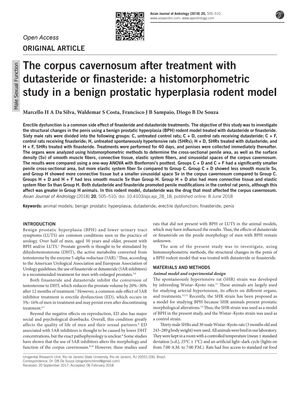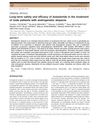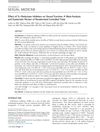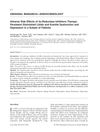The corpus cavernosum after treatment with dutasteride or finasteride: A histomorphometric study in a benign prostatic hyperplasia rodent model
January 2018
in “Asian Journal of Andrology”

TLDR Dutasteride caused more penile tissue changes than finasteride, possibly increasing erectile dysfunction risk.
In the 2018 study involving 60 male rats, researchers investigated the effects of dutasteride and finasteride, both 5-alpha-reductase inhibitors, on the penile morphology in a benign prostatic hyperplasia (BPH) rodent model. The rats were divided into six groups, including untreated controls, controls treated with either drug, untreated spontaneously hypertensive rats (SHRs) as a BPH model, and SHRs treated with either drug. After 40 days, the penises were histomorphometrically analyzed. The study found significant morphological changes in the corpus cavernosum, with dutasteride-treated rats showing a greater reduction in smooth muscle density and an increase in connective tissue and elastic system fiber surface density compared to finasteride. These changes suggest that erectile dysfunction observed in men treated with these drugs may be due to penile fibrosis. The study suggests finasteride might be preferable for patients concerned about erectile dysfunction, but acknowledges that further research is needed to confirm the reversibility of these changes and to explore the effects of different doses.
View this study on journals.lww.com →
Cited in this study

research Risk of erectile dysfunction associated with use of 5-α reductase inhibitors for benign prostatic hyperplasia or alopecia: population based studies using the Clinical Practice Research Datalink
Taking 5-α reductase inhibitors for prostate enlargement or hair loss does not significantly raise the risk of erectile dysfunction.

research Long-term safety and efficacy of dutasteride in the treatment of male patients with androgenetic alopecia
Dutasteride safely promotes hair growth and reduces hair loss, with mild side effects.

research Effect of 5α-Reductase Inhibitors on Sexual Function: A Meta-Analysis and Systematic Review of Randomized Controlled Trials
5α-reductase inhibitors increase the risk of sexual dysfunction, especially in men with enlarged prostate.
research Adverse Effects and Safety of 5-alpha Reductase Inhibitors (Finasteride, Dutasteride): A Systematic Review.

research Combination therapy with finasteride and low-dose dutasteride in the treatment of androgenetic alopecia
Finasteride and low-dose dutasteride combo improves hair growth and reduces hair loss with no major side effects.

research Morphometric-stereological and functional epididymal alterations and a decrease in fertility in rats treated with finasteride and after a 30-day post-treatment recovery period
Finasteride causes lasting fertility decrease in rats.

research Effects of Oral Finasteride on Erectile Function in a Rat Model
Finasteride reduces corpus cavernosum weight but doesn't affect erectile response in rats.

research Adverse Side Effects of 5α‐Reductase Inhibitors Therapy: Persistent Diminished Libido and Erectile Dysfunction and Depression in a Subset of Patients
Some patients taking finasteride or dutasteride may have ongoing sexual problems and depression even after stopping the medication.

research Effects of the 5α-Reductase Inhibitor Finasteride on Serum Levels of Gonadal, Adrenal, and Hypophyseal Hormones and its Clinical Significance: A Prospective Clinical Study
Finasteride reduces hair loss and treats BPH without major hormone changes, but may cause sexual dysfunction.